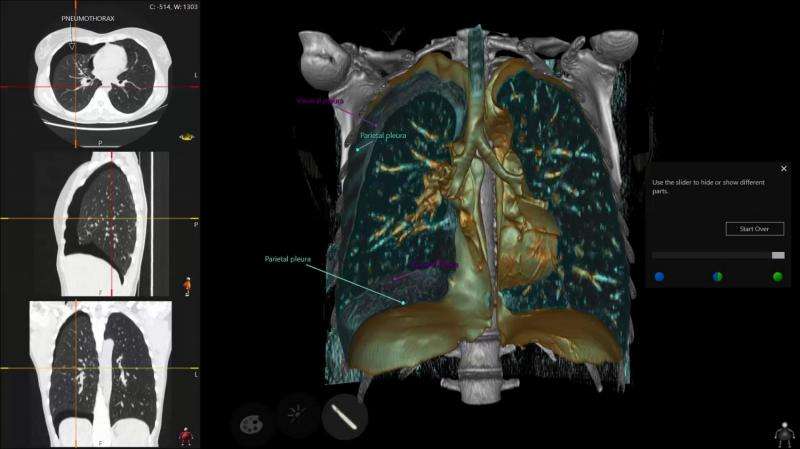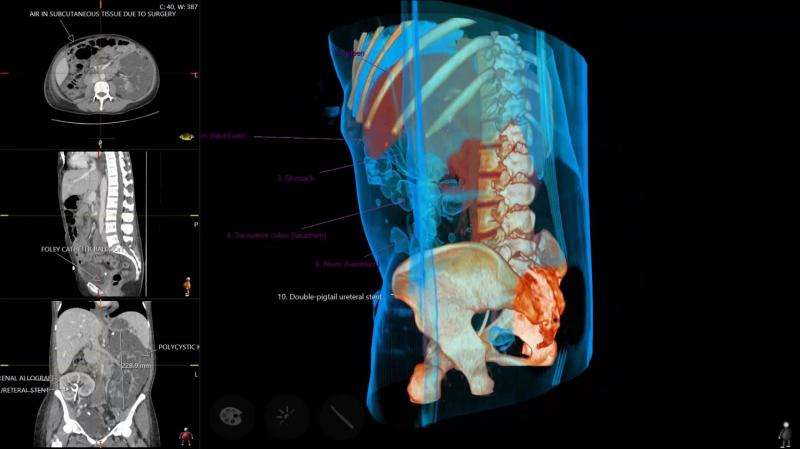Virtual scalpel aids anatomy lessons
First-year medical students at the University of British Columbia will begin using a state-of-the-art touch-screen table that displays detailed images of internal anatomy that can be rotated, enlarged and even sliced open. The anatomy visualisation table will be used with traditional anatomical dissections to teach first-year medical students about human anatomy and the medical conditions they are likely to encounter as physicians.
The device also will familiarise students with the radiological images that have become a core tool in the diagnosis and treatment of patients.
The 500-pound, 5-foot by 3-foot table displays primarily computed tomography (CT) scans of the entire body, including bones, muscles, organs and connective tissue.
Instructors can customise the table's images for the lessons they want to convey, showing anonymised patients with diseases and injuries that are deemed particularly relevant to the curriculum and to the practice of medicine.

Pneumothorax on the virtual anatomy table. Credit: University of British Columbia
"Medical imaging provides an increasingly revealing window into human anatomy and physiology," says Dr. Dermot Kelleher, dean of the faculty of medicine. "But medical schools are utilising just a fraction of its educational potential. We intend to show how powerful visualisation technology can be in training the next generation of physicians."
The table, made by the Sweden-based Sectra AB, will be used in UBC's gross anatomy lab in conjunction with traditional teaching through dissection. Groups of students will take turns with the device, moving from their dissection tables to the touch-screen device and back again.
UBC is the first Canadian medical school to use a Sectra table, and one of only 16 in North America, thanks to a generous donation from the London Drugs Foundation.
"The anatomy visualisation table highlights aspects of anatomy that are often difficult to see in the tightly-packed confines of a human body," says Claudia Krebs, a professor of teaching in anatomy in the Faculty of Medicine. "This technology allows students to understand how the various parts fit together – and how a problem with one part can easily affect another."
The device was demonstrated for two dozen UBC faculty members at Vancouver General Hospital two years ago, and two faculty members observed its use in Swedish medical schools last year, before the Faculty of Medicine decided to buy it. The faculty's instructors and medical education experts will closely monitor its impact on student learning.

Kidney transplant on the virtual anatomy table. Credit: University of British Columbia
The purchase of the table comes as UBC, which has the fifth-largest medical education program in North America, substantially revises its four-year medical curriculum. Many of the curricular changes are geared toward better integrating foundational sciences, such as anatomy, with clinical lessons about diagnosing and treating patients.
"Medical imaging has become a critical component of patient diagnosis and treatment in virtually all medical disciplines," says Dr. Bruce Forster, head of UBC's department of radiology.
"By enabling students to interact with these images from the moment they begin their medical education, we will be priming them for their future careers in whatever medical discipline they choose."
The London Drugs Foundation donated funds for the table and its operating costs. "As part of our ongoing commitment to health and education, London Drugs is proud to support the UBC Faculty of Medicine and the future learning of its students with the anatomy visualisation table," said John Tse, vice president, pharmacy, of London Drugs.
"This technology will provide the students with an enhanced clinical experience in their first year. The London Drugs Foundation is thrilled to be able to be part of this advancement."










